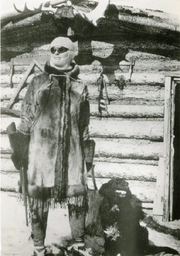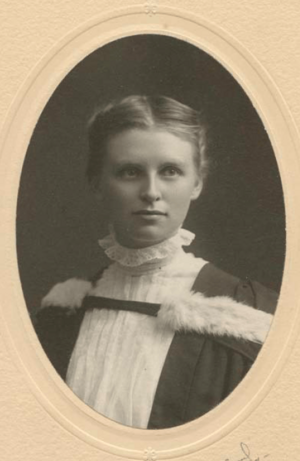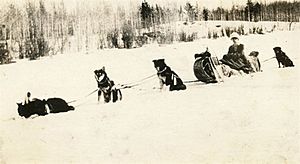Kate Rice facts for kids
Quick facts for kids
Kate Rice
|
|
|---|---|

Kate Rice outside her cabin on Wekusko Lake
|
|
| Born | December 22, 1882 St. Marys, Ontario, Canada
|
| Died | January 2, 1963 (aged 80) Minnedosa, Manitoba, Canada
|
| Nationality | Canadian |
| Other names | Mooniasquao, "The Red Lady", "Lady of the Lake" |
| Alma mater | University of Toronto |
| Occupation | Prospector, Writer, Trapper, Math Professor |
| Known for | First woman prospector |
Kate Rice (born December 22, 1882 – died January 3, 1963) was a brave Canadian adventurer, writer, and prospector. She explored and mined in northern Manitoba. Kate became famous for her exciting life and for being one of the few women to succeed in the mining world.
Contents
Early Life and Family Background
Kathleen Creighton Starr Rice was born in 1882 in St. Marys, Ontario. Her family was well-off. Her parents were Henry Lincoln Rice and Charlotte "Lottie" Carter Rice.
Kate's grandfather, Rev. Dr. Samuel Dwight Rice, was a Methodist minister. He even started a college for women in Hamilton, Ontario. This shows that her family valued education for everyone.
Her father, H.L. Rice, taught Kate many outdoor skills from a young age. At just six years old, she learned to canoe and camp along the St. Mary's River. He also told her exciting stories, which gave her a lifelong love for adventure and nature.
Education and Career Journey
Kate Rice was a very smart student. She attended the University of Toronto. There, she won the prestigious Edward Blake Scholarship twice. She focused her studies on Mathematics, Physics, and Astronomy. Kate graduated from the university in 1906.
After college, Kate moved west in 1908 to Tees, Alberta, where she taught at a summer school. Later, she became a Mathematics Professor at Albert College in Belleville, Ontario. She also taught in Yorkton, Saskatchewan during 1911 and 1912.
While teaching, Kate began exploring the Canadian Rockies. She discovered a passion for mountaineering, especially in the Cascade Mountains. She later joined the Alpine Club of Canada.
At 29, Kate decided she wanted to homestead and help open up Canada's northern frontier. At that time, women in Canada could not legally own property until 1929. So, Kate's brother, Lincoln, bought land for her in his name. This land was about 6 kilometers north of The Pas, Manitoba. Kate started farming there in 1913.
Becoming a Prospector
Soon after Kate moved to The Pas, gold was discovered about 90 kilometers north on Beaver Lake. This news sparked Kate's interest in prospecting. She began to study geology and read everything she could find about it.
Kate also became friends with the local Cree people. She learned their language and how to hunt and trap animals. In 1914, she borrowed money from an old college friend. She then hired a Cree guide to take her north to Beaver Lake by dogsled. She traveled even further north by canoe to Brochet to begin her prospecting journey.
On this first trip, Kate found zinc at Reindeer Lake. However, she didn't claim it because there was no railway nearby, making it hard to develop.
In 1915, Kate used her own dog team to explore the Beaver Lake area. Here, she staked her first claims. During this time, she hired "Old Isaac," a local Cree Elder. He taught her how to trap, hunt, mush dogs, and shoot. The local Cree people called her "Mooniasquao," which means "white woman."
The next year, Kate partnered with Richard "Dick" Woosey. They built a remote cabin together and worked as a team. They continued to prospect in areas like Herb Lake, Wekusko Lake, and Snow Lake. They also explored the Burntwood and Flin Flon mineral belts.
In 1928, Kate visited Toronto and started getting a lot of media attention. People were amazed by this tall, smart woman with golden hair who was succeeding in the tough world of northern prospecting. Newspapers like the Toronto Star often wrote about her adventures. Kate sometimes wrote articles for the Toronto Star herself, sharing her experiences in the North.
Kate made many important discoveries of copper and nickel. These finds eventually led to the creation of large mining operations. They also helped develop the mining center of Thompson, Manitoba.
Later Years and Recognition
From 1940 onwards, Kate Rice lived in her log cabin on an island in Wekusko Lake. She spent her time writing, gardening, fishing, trapping, and prospecting in her small canoe named "Duckling." She also wrote articles for scientific journals about her observations of weather and stars in northern Canada.
Kate was also known for her skill in raising and training sled dogs. She could mush them without needing a whip, which was very unusual.
After many years living alone, Kate became concerned about her well-being. In 1960, at age 77, she left the wilderness to seek help. Doctors assured her she was not unwell, simply "just a prospector." In 1962, Kate moved into a nursing home in Minnedosa, Manitoba. She passed away a year later.
Kate Rice received several important recognitions for her pioneering spirit. In 1946, the island where she lived on Wekusko Lake was officially named Rice Island. In 2013, a plaque was placed on the island to honor her. It reads: "In Memory of Kathleen ‘Kate’ Rice. With the aurora borealis illuminating her pioneering trail, her courage and ethics spoke volumes, while her deeds and prospecting helped define the North we know."
In 2009, the Snow Lake newspaper, Underground Press, helped raise money for a headstone on Kate’s grave in Minnedosa. It reads: "Prospector and Pioneer of the North, Extraordinary Woman of the Wilds." A similar stone was placed on Dick Woosey's grave in The Pas.
In 2013, Kate Rice was inducted into the Canadian Mining Hall of Fame. This is a great honor for her contributions to mining in Canada. Her papers, including an unpublished memoir, were donated to the University of Manitoba Archives.
Images for kids




